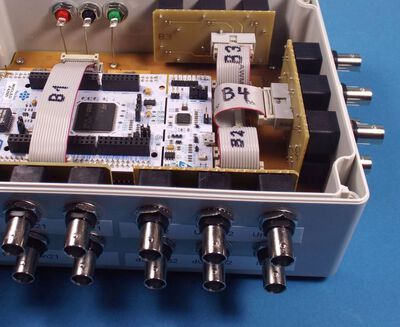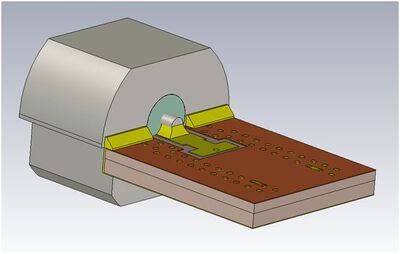Applications
An excerpt from our product gallery
LTE bandpass filter for laboratory operation
Especially in rural areas or under difficult reception conditions, regeneration of weak mobile signals is necessary for a stable mobile connection. Two-way amplifiers (uplink and downlink), also called repeaters, compensators, or boosters, are often used as relay stations for this purpose.


PCB prototype laboratory
In our in-house PCB prototype lab, multilayer PCBs with galvanic vias can be created within a few hours. The surfaces are gold-plated as standard for good long-term stability. The gold surface can be used for wire bonding.
We have a great deal of freedom in choosing the PCB material. We coat the materials with a light-sensitive layer and then process them. Mixed structures with different substrates are also possible, for example, Rogers combined with FR4.
Prototypes are often built from the substrate that will later be used in series production; this avoids the otherwise unavoidable re-tuning of the high-frequency circuit when using a different PCB material.
If desired, the boards can also be coated with a commercially available solder mask.
The layout data is either created with our own layout tools (Altium Designer, Eagle, KiCad), or Gerber or DXF data can be processed by the customer.
The achievable assembly accuracies are comparable to those of volume manufacturers.
ARM programming
Based on the ARM® Cortex® microcontroller (STM32 Cortex M4), we offer a flexible solution for a wide range of sensor applications. Signal conditioning, readout, filtering, and measurement data processing are all performed on a single board. The software can be adapted to the specific measurement requirements.
The system shown here provides 18 inputs. Three analog inputs can be sampled simultaneously and in phase (2.4 MSPS at 12-bit resolution).
The DSP functionality is also located on the Cortex® MCU and includes functions such as FFT, FIR, and IIR filters, as well as other mathematical functions. UART, SPI, and an Ethernet interface are available for configuring external components and outputting the processed data.


RF connector-board transitions
Transitions from coaxial connectors such as SMA, SMB, MCX or N connectors to a microstrip or stripline must be designed with low matching losses.
It is often necessary to optimize the design or layout of the transition through a field simulation. This is typically done using a CST simulation.
Since the transition is also subject to mechanical stress, the mechanical connection of the plug or socket must be designed to be correspondingly robust.
Typically, test boards are created first, on which verification and optimization in the time and frequency domains (TDR measurement technology, S-parameter measurement technology) are carried out. Measurements up to 40 GHz or 25 ps time resolution can be performed in-house.
The adjacent image shows the design of an SMA stripline connector. For good mechanical stability, the connector is soldered all the way around to the PCB.


